
Why Do Hips Get Tight

Hips tighten when muscles around the hip joint shorten and lose flexibility. Common causes include:
- Sitting too long (office work, driving, or TV time)
- Lack of movement in daily routine
- Stress (hips store emotional tension)
- Overtraining without proper stretching
- Weak core and glutes, forcing hips to take extra load
Effects of Hip Tightness on the Body
Tight hips don’t just cause local stiffness they affect the whole body. Some common issues are:
- Lower back pain
- Poor posture and slouching
- Limited range of motion in legs
- Knee and hamstring strain
- Reduced athletic performance
Benefits of Stretching Tight Hips

Daily hip stretches can:
- Reduce stiffness and pain
- Improve blood circulation to muscles
- Prevent injuries and muscle imbalances
- Support better posture
- Increase flexibility for sports, workouts, or dance
- Release stress and stored tension
Safety Tips Before Stretching

Daily hip stretches can:
- Reduce stiffness and pain
- Improve blood circulation to muscles
- Prevent injuries and muscle imbalances
- Support better posture
- Increase flexibility for sports, workouts, or dance
- Release stress and stored tension
Everyday Stretch Routine for Tight Hips

Here’s a step-by-step routine you can follow daily (10–20 minutes).
Butterfly Stretch
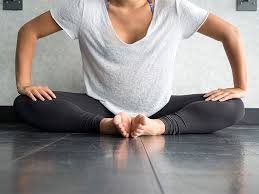
How to do it
- Sit on the floor, bring the soles of your feet together.
- Hold your feet with your hands and let your knees fall outward.
- Keep your back tall and breathe deeply.
Benefits: Opens the inner thighs, hips, and groin. Perfect for people who sit long hours.
Pigeon Pose

How to do it:
- From plank or downward dog, bring your right leg forward and bend it at the knee.
- Extend the left leg straight behind you.
- Lean forward gently for a deeper stretch.
Benefits: Deeply stretches hip flexors and glutes. Excellent for runners and athletes.
Lunge Stretch Low Lunge
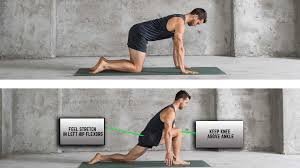
How to do it:
- Step one foot forward into a lunge.
- Keep the back knee on the ground.
- Push hips forward slightly while keeping chest upright.
Benefits: Stretches hip flexors, thighs, and groin. Improves posture after long sitting.
Figure Four Stretch
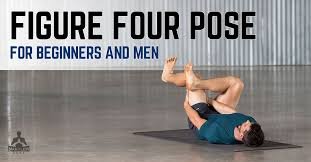
How to do it:
- Lie on your back with knees bent.
- Cross your right ankle over your left thigh.
- Pull your left thigh toward your chest.
Benefits: Relieves tension in hips, glutes, and lower back. Great for office workers.
Seated Forward Fold
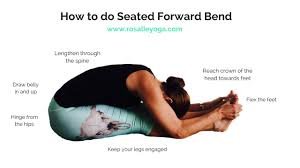
How to do it:
- Sit with both legs extended straight.
- Bend forward from the hips, reaching toward your feet.
- Keep your spine long, don’t hunch.
Benefits: Opens hamstrings, lower back, and hip joints. Promotes relaxation.
Happy Baby Pose

How to do it:
- Lie on your back, bend knees toward your chest.
- Hold the outer edges of your feet with your hands.
- Gently rock side to side.
Benefits: Stretches hips and inner thighs. Calms the mind and relieves fatigue.
Hip Circles

How to do it:
- Stand with feet hip-width apart.
- Place hands on hips and make slow circular movements.
- Repeat 5–10 circles each direction.
Benefits: Warms up hip joints, improves flexibility, and boosts circulation.
Frog Stretch
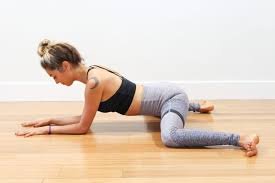
How to do it:
- Get on all fours, spread your knees wide apart.
- Keep feet flat, lean forward slightly.
- Hold the pose while breathing slowly.
Benefits: Strong hip opener for inner thighs and groin. Increases mobility.
Reclined Bound Angle Pose

How to do it:
- Lie flat on your back.
- Bring soles of feet together, let knees fall open.
- Place hands on belly or by sides.
Benefits: Deeply relaxes hips and lower back. Great as a finishing stretch.
Tips to Make It a Daily Habit
- Do these stretches right after work or before bedtime.
- Pair them with relaxing music to make it enjoyable.
- Even if busy, do 3–4 stretches (5–7 minutes).
- Track progress by noticing reduced stiffness each week.
Morning Hip Stretches to Start Your Day
Doing hip stretches in the morning can reduce stiffness from sleep and energize you. Best morning poses:
- Cat-Cow Stretch
- Hip Circles
- Low Lunge
Evening Hip Stretches for Relaxation
Evening is the best time to release tension after sitting or moving all day. Try:
- Butterfly Stretch
- Happy Baby Pose
- Reclined Bound Angle Pose
Dynamic vs Static Hip Stretches
- Dynamic stretches (hip swings, lunges with movement) are best before workouts.
- Static stretches (holding poses for 30–60 seconds) are best for after workouts or before bed.
Hip Stretches for Office Workers
Quick desk-friendly stretches:
- Seated Figure Four
- Standing Quad Stretch
- Desk Lunge
Hip Stretches for Athletes and Gym Goers
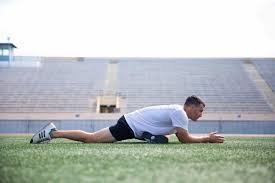
Athletes need stronger hip mobility to prevent injuries. Focus on:
- Pigeon Pose
- Frog Stretch
- Deep Squat Hold
Best Breathing Techniques During Hip Stretches
Breathing helps relax tight muscles:
- Inhale deeply through the nose.
- Exhale slowly through the mouth.
- With every exhale, sink deeper into the stretch.
How Stress Affects Hip Tightness
Stress triggers muscles around the hips to contract. This is why hips are often called the “emotional storage center.” Hip stretches can release both physical and emotional tension.
The Role of Yoga in Hip Flexibility
Yoga poses like Warrior II, Triangle Pose, and Bound Angle Pose improve hip strength and flexibility while calming the mind.
Common Mistakes People Make While Stretching
- Forcing the stretch instead of easing into it.
- Holding the breath.
- Rounding the back in forward folds.
- Not warming up before deep stretches.
Tools That Can Help Foam Rollers and Straps
Using tools can enhance hip stretches:
- Foam roller: Relieves tight muscles before stretching.
- Strap or belt: Helps beginners hold stretches safely.
Beginner Friendly Modifications
If poses feel too intense:
- Place a pillow under hips in Pigeon Pose.
- Keep knees higher in Butterfly Stretch.
- Use yoga blocks for support.
Advanced Hip Openers for Deep Stretch
For experienced stretchers:
- Full Lotus Pose
- Double Pigeon (Fire Log Pose)
- Deep Squat with Hip Opener
How Long Does It Take to Loosen Tight Hips
- Light results: 2–3 weeks of daily stretching
- Noticeable improvement: 6–8 weeks
- Full flexibility: depends on consistency and body type
Signs You’re Overstretching
- Sharp or pinching pain
- Tingling or numbness
- Soreness lasting more than 2 days
Nutrition and Hydration for Healthy Muscles
- Stay hydrated to keep muscles supple.
- Eat foods rich in magnesium, potassium, and protein to support recovery.
How Strong Glutes Support Hip Health
Weak glutes force hips to overwork. Strength exercises like bridges, squats, and clamshells improve hip stability.
Hip Stretches for Lower Back Pain Relief
Some hip stretches directly ease back pain:
- Figure Four Stretch
- Child’s Pose
- Happy Baby Pose
Partner or Assisted Hip Stretches
Having a partner gently push your knees or support your back can help deepen the stretch safely.
Creating a Weekly Hip Mobility Routine
Mix static and dynamic stretches:
- 3 days dynamic (before workouts)
- 4 days static (before sleep)
Lifestyle Changes to Keep Hips Healthy
- Stand up every 45–60 minutes.
- Use a standing desk if possible.
- Walk or cycle daily.
- Sleep with a pillow between your knees if side-sleeping.
The Connection Between Hip Flexibility and Mental Health
Tight hips often store emotional tension. Hip stretches help release stress, reduce anxiety, and improve overall mood.
How Tight Hips Affect Your Sleep Quality
Sleeping with tight hips can cause discomfort and restless nights. Reclined Bound Angle Pose before bed can improve sleep.
Stretches You Can Do Without a Mat
Not at home? Try standing figure-four, lunges, or hip circles without needing a yoga mat.
Hip Stretches for Runners and Cyclists
Sports like running and cycling shorten hip flexors. Pigeon Pose and Low Lunge are musts for recovery.
Seated Hip Stretches You Can Do While Traveling
Perfect for flights or long drives: seated ankle-to-knee stretch, seated twists, and seated figure-four.
Using Resistance Bands for Hip Flexibility
Resistance bands can add depth to stretches like hip openers, leg raises, and bridges.
The Role of Balance and Core in Hip Mobility
Strong abs and balance improve hip function. Combine core strengthening with stretches for best results.
Best Warm Ups Before Hip Stretches
Marching in place, leg swings, and light squats prepare hips for deeper stretches.
Cooling Down After Hip Stretches
Slow breathing, reclined poses, and gentle side stretches help muscles relax and recover.
Stretches to Avoid if You Have Hip Injuries
Avoid deep lunges or splits if recovering. Stick to gentle stretches like Butterfly and Happy Baby.
Physiotherapist Approved Hip Mobility Tips
Physical therapists recommend short but consistent stretching sessions over one long weekly session.
How Age Affects Hip Flexibility and What to Do
Flexibility decreases with age, but consistent stretching slows this process and keeps hips mobile.
Hip Mobility for Pregnant Women
Safe stretches include Butterfly Pose, Cat-Cow, and Supported Squats. Always avoid overstretching.
Hip Stretches for Better Squats and Deadlifts
Strong and flexible hips improve performance in weightlifting. Try Frog Stretch and Pigeon Pose.
How Long Should You Hold Each Hip Stretch
- Beginners: 20–30 seconds
- Intermediate: 30–60 seconds
- Advanced: 1–2 minutes with deep breathing
Final Thoughts and Daily Action Plan
Set aside 10–20 minutes daily for your hips. Mix static and dynamic stretches, breathe deeply, and track progress weekly.
Conclusion
Tight hips are common, but they don’t have to control your comfort or mobility. With the right combination of daily stretches, yoga, breathing techniques, and lifestyle adjustments, you can restore hip flexibility and prevent pain.Even 10–15 minutes a day is enough to make your hips more open, your posture better, and your body stronger. Consistency is the secret.
Start today your hips will thank you tomorrow.